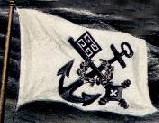
Company emblem
 The S/S Hudson
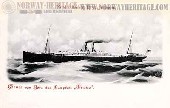 S/S Trave
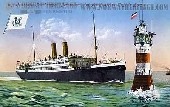
Barbarossa class
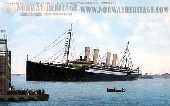 S/S Kaiser Wilhelm der Grosse
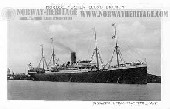
Rhine class
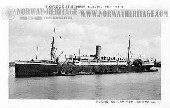
General class
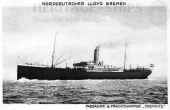
Köln class
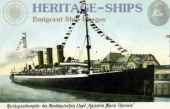
Kaiserin Maria Theresia
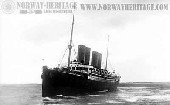
Kronprinz Wilhelm
 Kaiser Wilhelm II (2)
 Steerage passengers
|
By 1879 the North German Lloyd was establishing a network of passenger agent around Europe. The first general agent in Norway was O. Svenson in Kristiania. From 1879 he was authorized to convey passenger by the Norddeutcher Lloyd's steamships via Fredrikshavn and Bremen to New York or Baltimore, and on to the final destinations in America. When going via Fredrikshavn in Denmark, the emigrants would go by a DFDS ship from Kristiania, and continue from Fredrikshavn by train to Hamburg or Bremen. However, there were also regular routes from all mayor Norwegian ports to Hamburg by steamship. In 1880 the authorization was extended to cover conveyance of emigrants by Norddeutcher Lloyd's steamships via Fredrikshavn or Hamburg and Bremen to New York or Baltimore, and via Hull or London to Southampton from there to New York. There was also plans to introduce a direct service from Kristiania to New York, and authorization was given for that route on July 28th, 1880 but was withdrawn soon after on August 15th.
1880 newspaper announcement:
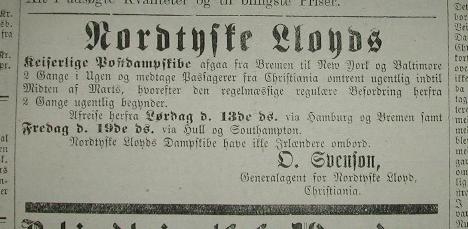
"The North German Lloyd's Royal Mail Steamers depart from Bremen to New York and Baltimore twice a week, taking passengers from Christiania weekly until the middle of March, when the regular twice a week service from Christiania starts. Departure from Christiania Saturday 13th this month via Hamburg and Bremen and Friday 19th this month via Hull and Southampton. The North German Lloyd steamers do not have Irish passengers on board. O. Svenson, General agent for the North German Lloyd, Christiania."
The price given for a voyage from Christiania to Chicago in 1880 was 35 Dollars
|
The Norddeutscher Lloyd was founded in 1857. In the company emblem, an anchor and the Bremen key is crossing each other, surrounded by a wreath of oak leaves. The company was often called the "Bremen Line". During the first year of its operations a line to England was started with three small steamers, the "Adler", "Möwe" and "Falke", and four large screw steamers were ordered in England and Scotland for the New York service.
On June 19, 1858, at 6 o'clock in the afternoon; the "Bremen" left the wharf at Bremerhaven on her maiden voyage to New York, carrying 100 tons of freight, 1 cabin and 93- steerage passengers. This was the first transatlantic sailing of a Norddeutscher Lloyd steamer. She arrived in New York on July 4, at 7 o'clock in the morning.
During the same year three more transatlantic steamers, the "Hudson", the "Weser", and the "New York", were added to the service and with those four steamers a regular fortnightly service to New York was commenced. In the year 1859 the completion of the Geeste railway between Bremen and Bremerhaven allowed all passengers to be carried from Bremen direct to the steamship. In the following year a substantial success was achieved. The postal authorities, in England and the United States entrusted the Company with the carriage of their mails, thus placing the new line on an equal footing with the older English lines, the Cunard and Inman.
Notwithstanding various difficulties of a technical character and in spite of the American civil war, business continued to advance. A new steamer, the "America", started on her maiden trip to New York on May 23, 1863. With a speed of 13 knots an hour on a daily coal-consumption of 45 tons, she was one of the fastest steamers of her day. Though built by Caird & Co., Greenock her cast steel propeller shaft was the product of Krupp in Essen.
On the termination of the American Civil War in 1865, there naturally followed a large increase in the trade with the United States and in the emigration to that country. The great increase in the traffic was made evident by the fact that the fortnightly sailing could no longer meet the demand. In 1866, 2 new steamers, the "Deutschland" and "Union" were added to the fleet. In 1867 the weekly service between Bremen and New York with eight big steamers was inaugurated. 65 round trips to New York in the previous year having yielded receipts amounting to about 2½ million Thalers. Again the carriage of the mails was entrusted to the Lloyd by the Postmaster General of the United States. These very favorable results suggested to the management the idea of adding new lines. In the spring of 1866 the line to Baltimore was established. Certain very favorable working arrangements between the Lloyd and the Baltimore and Ohio Railroad Company facilitated matters. The new line was opened with the steamer "Baltimore" on March 1, 1868. By 1874 the North German Lloyd ships averaged 11 days and 13 hours on the transatlantic crossing.
The Franco-Prussian war caused a temporary check in the Company's development. But as early as the autumn of 1870 the traffic was resumed in its full extent. In the following year a new line to the West Indies was started, hut it did not fulfill expectations, and its continued operation seemed unpromising. On January 18, 1872, the Company's new dry-dock in Bremerhaven was opened. In 1875 a new line to South America was established, and three years later it became necessary to divide this line into two distinct services, one to Brazil and the other to the River Plate.
Norddeutscher Lloyd - advertising card - "Norddeutscher Lloyd - Bremen nach New York, Baltimore, New Orleans & La Plata Staaten". The ship on the picture looks like a Werra class steamer. (Support Norway Heritage: Purchase a copy)
Prior to 1878 the normal average speed of a steamer was about 12 knots, while 20 years before that a speed of 8 knots was regarded as a great achievement. In 1878 however, a speed as high as 16 knots was attained by the steamer "Arizona" of the Guion Line. This great advance was fully appreciated by the directors of the Norddeutscher Lloyd in Bremen. Their aim during the years following was to establish a regular express service between Bremen and New York. The first express steamer was the "Elbe", which was placed in service in 1881. The first captain of a Lloyd express steamer was Herr Chr. Leist, who made five trips in the "Elbe" during the year 1881. The "Elbe", was quickly followed by the "Werra" and the "Fulda", so that in 1883, by including in this service the fastest of the older steamers, the Lloyd was enabled to inaugurate a regular weekly express service between Bremerhaven and New York, whereby the length of the passage was reduced to between 8 and 9 days. In the year 1881 the Company's steamers had traveled a distance equal to 23 times the circumference of the earth.
During this new period of its growth and prosperity the Company celebrated its 25th anniversary on February 20, 1882. At the time it owned 29 transatlantic steamers, 7 steamers for European traffic, 14 river steamers, and 48 lighters; altogether 97 vessels representing a total of 104,500 registered tons. The Lloyd was thus the fourth largest steamship company in the world, being surpassed only by the Peninsular & Oriental Steam Navigation Company, and by the two French lines, the Compagnie Generale Transatlantique and the Messageries Maritimes.
The appreciation of the Lloyd's Express steamers by the German and the American postal authorities justified the building of more of the same class. Accordingly, in 1883, two new steamers, the "Eider" and the "Ems", with a speed of 17 knots, were added to the North American fleet. These were followed two years later by the sister ships "Aller", "Trave" and "Saale" of 18 knots and between 1887 and 1890 four additional express mail steamers were completed, the "Lahn", "Kaiser Wilhelm II" (later "Hohenzollern"), "Spree" and "Havel".
The transatlantic passage by Norddeutscher Lloyd steamers, Bremen - Southampton - New York, as described 1888-89
The Lloyd did not, however, stop here, but caused to be built a new type of steamer in order to meet the demands of the immensely increasing traffic. The steamers of the "Dresden" and "Gera" class represented a new type, a combination of freight and passenger steamer, having capacity for a large amount of cargo as well as accommodation for a considerable number of cabin and steerage passengers. Many of the steamers could also be adapted to act as military transports.
In the year 1885 the contract with the Imperial German Government for the establishment and maintenance of mail steamship lines to Eastern Asia and to Australia was signed. The new Imperial mail lines demanded by the contract with the Imperial Government were as follows : A main line to China with branch lines to Japan and Korea, a main line to the Australian Continent with branch lines to the Samoa and Tonga Islands, and a branch line from Trieste via Brindisi to Alexandria. The Vulcan Shipbuilding & Engineering Company of Stettin received orders for the three sister ships "Preussen", "Sachsen" and "Bayern", of 3600 tons and a speed of 14 knots, also for the steamers intended for the branch lines, of about half the size of the others, the "Stettin", "Lubeck" and "Danzig", of about 1500 tons and a speed of 12½ knots. Besides, several of the Norddeutscher Lloyd's mail steamers were reconstructed so as to adapt them for the new lines, particular care being taken to render these steamers suitable for service in the tropics. Preparations were completed so expeditiously that the line to Eastern Asia was inaugurated with the steamer "Oder" as early as June 30, 1886. The new Imperial mail line to Australia was opened on July 14, 1886, with the steamer "Salier".
In the spring of 1891 an ocean-mail service was established on board the Express steamers of the Norddeutscher Lloyd and the Hamburg America Line, for expediting the distribution of the mails carried between Bremerhaven and Hamburg respectively, and New York. This important step was due to the efforts of Postmaster General Stephan, and the American postal authorities readily accepted the proposal. Previously the mail matter was not sorted until after arrival in New York, Bremen or Hamburg; but under the new arrangement this was performed during the passage by postal officials in a sorting room fitted on board the steamers, so that on arrival the mails could be immediately forwarded to their destination. The rooms fitted up on board the mail steamers were about 15 square meters in size and adjoining them were spacious rooms used for storing the big sealed mail sacks. The first ocean mail from Bremen was forwarded on March 24, 1891, in the "Havel". The number of mail sacks containing letters and printed matter increased from year to year.
In 1891 the Lloyd started a new steamship line, Genoa Gibraltar-New York. The steamers "Werra" and "Fulda" were withdrawn from the Bremen-New York service, and placed in the new service. Later the Mediterranean branch line was discontinued and the mails landed and embarked at Naples. The monthly Samoa was replaced by an eight-weekly service between Singapore and New Guinea via Batavia. For this service a new style of steamers with increased freight capacity, and passenger accommodation specially designed and appointed for service in the tropics were introduced. These vessels were called "Prince" class, and were fitted with twin-screws, a system which had been first applied to the fast cruisers and dispatch boats of the Imperial Navy. The extraordinarily favorable results achieved with the twin screws did not escape the attention of the merchant service. The frequently occurring cases of broken propeller shafts suggested that the twin screw system would insure greater safety as well as comfort in the transatlantic steamers. And accordingly both the German and the English steamship companies commenced to fit their new steamers with twin-screws.
In 1896 an entirely new type of vessel was created, the "Barbarossa" class. In the construction of these vessels the aim was to provide for an unusually large quantity of freight, as well as for a large number of passengers in the three classes, while keeping the cabin accommodation entirely separate from the freight space.
In the annual report for the year 1893, the Committee intimated that the Company contemplated the adoption of the twin-screw system for the Express steamers, but that further experience was necessary. Considerable progress having meanwhile been made in the art of shipbuilding, the Committee two years later placed an order with the Vulcan Co. of Stettin for a twin-screw express mail steamer. This was the four stacker "Kaiser Wilhelm der Grosse", which in spite of her greater displacement and with only 28,000 horse power far surpassed the "Campania" and "Lucania" in speed. On May 4, 1897, the "Kaiser Wilhelm der Grosse" was launched, in the presence of the Emperor, many members of the Reichstag, and other officials and some 30,000 citizens. On September 26 of the same year the steamer made her first appearance in New York. She was greeted by a great crowd at the dock in Hoboken, and in a single day was visited by 40,000 people.
To meet the special requirements of the freight and steerage passenger traffic on the New York line the NDL acquired two types of steamers known as the Rhine class and the General class. To the Rhine class belonged the steamers "Neckar", "Rhein" and "Main", completed between 1899 and 1900. The General class comprised the steamships "Zieten", "Seydlitz", "Gneisenau", "Roon" and "Scharnhorst", completed between 1902 and 1904.
The awning deck steamers of the Köln class which were built for the Baltimore and Galveston lines, represented an entirely different type. They were built with a very limited cabin accommodation, but had ample space for the conveyance of a large number of steerage passengers, and for the transport of large quantities of grain and cotton. The steamers of the Köln class were the "Köln", "Frankfurt", "Hannover", "Cassel", "Breslau", "Chemnitz" and "Brandenburg". The Köln class steamers were all completed between 1899 and 1901.
A new and valuable addition to the express fleet was the steamer "Kaiserin Maria Theresia", built by the Vulcan Co., at Stettin and placed in service in 1900. This graceful vessel, 546 feet long and 52 feet wide, with her three big funnels, has in the short time she has been running between Bremen and New York, become a favorite with the traveling public. In January, 1901, she made her first appearance at Genoa, to join the express service between Italy and New York.
In the autumn of 1901 a new leviathan express steamer the "Kronprinz Wilhelm" was placed in service. She belonged to the same type as the "Kaiser Wilhelm der Grosse". Shortly after the Kaiser Wilhelm II (2) was launched. The "Kaiser Wilhelm II" represented a great advance over all former steamers. The displacement of the vessel when fully loaded was about 26,000 tons. The tonnage was approximately 20,000 gross registered tons. As regards dimensions the vessel surpassed all the fast steamers then built Including the "Kaiser Wilhelm ll.", Germany by then had the four fastest merchant steamers of the world, namely the "Kaiser Wilhelm II.", "Kaiser Wilhelm der Grosse" and "Kronprinz Wilhelm" of the Norddeutscher Lloyd, and the "Deutschland", belonging to the Hamburg-America line. All built by the Vulcan Company at Stettin.
In 1904 a new service from Marseilles to Naples and Alexandria started and in 1909 a joint summer service between Bremen and Hamburg to Quebec and Montreal was instituted with the Hamburg America Line, Red Star Line and Holland America Line. Bremen - Galveston ships commenced calls at Philadelphia in March, 1910 and a new service started in 1913 to Boston and New Orleans.
At the outbreak of WWI, many North German Lloyd ships took refuge in US ports, and these were seized by American authorities in 1917. After the Armistice, the company lost every worthwhile ocean going steamer as war reparations, and in 1920 chartered ships from the US Shipping Board to resume services. They gradually rebuilt their fleet and in 1925 took over the Hamburg-Bremen Africa Line, the Dampschiff Reederei Horn and the Roland Line. In 1928 Quebec and Montreal services were resumed. During World War II, North German Lloyd again lost almost their entire fleet and again restarted with chartered ships. In 1970 the company amalgamated with Hamburg America Line to become HAPAG-Lloyd.
Sources:
Norddeutscher Lloyd Bremen, English Edition, ca. 1907
North Atlantic Seaway by N.R.P.Bonsor, 1960
Verdens Gang 1880-03-11
|